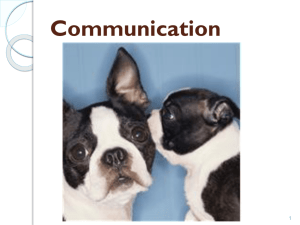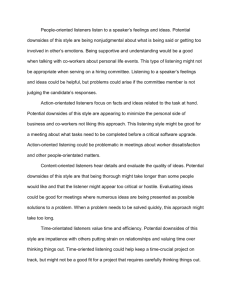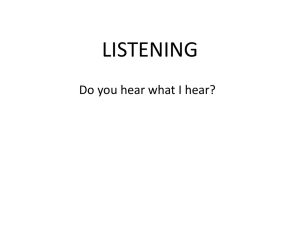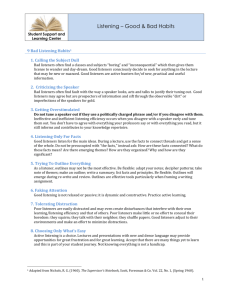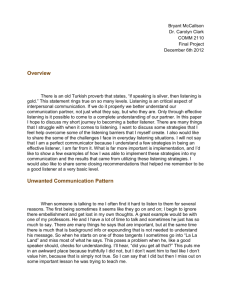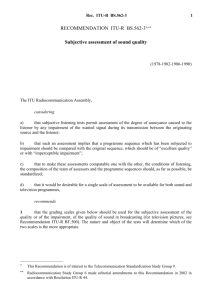Instructor Note 11:
advertisement
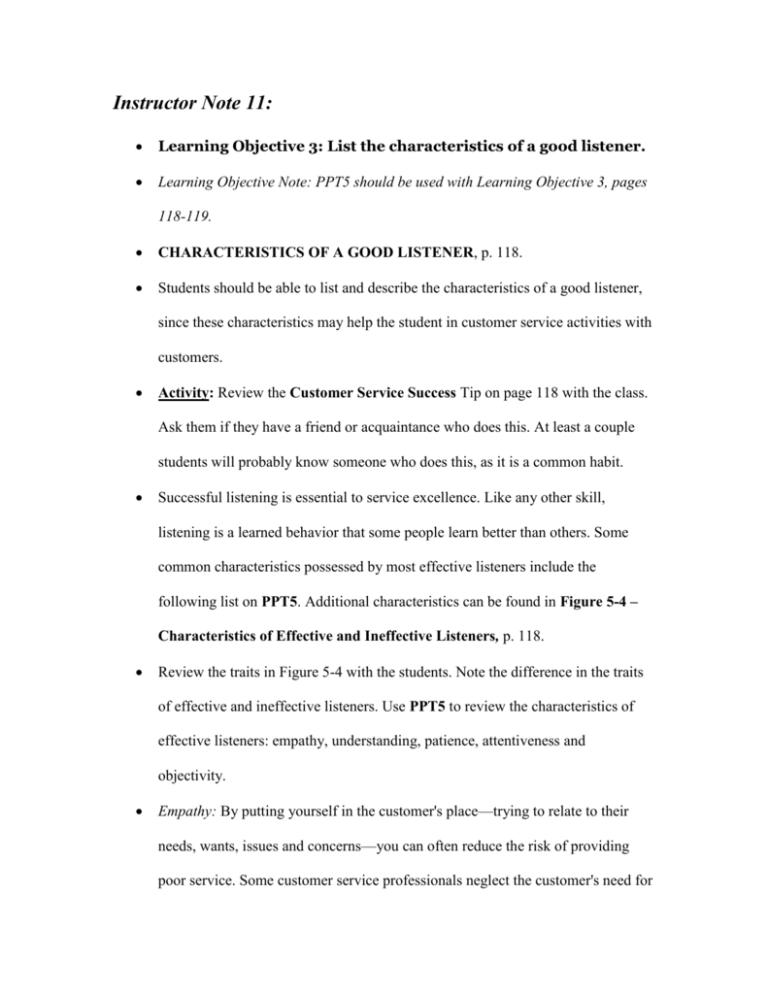
Instructor Note 11: Learning Objective 3: List the characteristics of a good listener. Learning Objective Note: PPT5 should be used with Learning Objective 3, pages 118-119. CHARACTERISTICS OF A GOOD LISTENER, p. 118. Students should be able to list and describe the characteristics of a good listener, since these characteristics may help the student in customer service activities with customers. Activity: Review the Customer Service Success Tip on page 118 with the class. Ask them if they have a friend or acquaintance who does this. At least a couple students will probably know someone who does this, as it is a common habit. Successful listening is essential to service excellence. Like any other skill, listening is a learned behavior that some people learn better than others. Some common characteristics possessed by most effective listeners include the following list on PPT5. Additional characteristics can be found in Figure 5-4 – Characteristics of Effective and Ineffective Listeners, p. 118. Review the traits in Figure 5-4 with the students. Note the difference in the traits of effective and ineffective listeners. Use PPT5 to review the characteristics of effective listeners: empathy, understanding, patience, attentiveness and objectivity. Empathy: By putting yourself in the customer's place—trying to relate to their needs, wants, issues and concerns—you can often reduce the risk of providing poor service. Some customer service professionals neglect the customer's need for compassion, especially in cases where the customer is dissatisfied. Such negligence tends to magnify or compound the effect of the initial poor service the customer received. Understanding: The ability to listen as customers verbalize needs and to ensure that you understand them is essential in accurately servicing the customer. Too often, you hear people say the words, "I understand what you mean," when it is obvious they have no clue to the level of emotion being felt. If this happens while a customer is upset or angry, the result could include such things as flared tempers, loss of business, bad publicity and, at the far end of the continuum, acts of violence. Patience: Many people spend time thinking of what they will say next rather than listening to what is being said. Taking time to slow down and actively listen to customers makes them feel important and allows you to better meet their needs. Patience is especially important when there is a language barrier or speech disability involved. Your job is to take extra care to determine the customer's needs, and then respond appropriately. In some cases, you may have to resort to the use of an interpreter or written communication in order to determine the customer's needs. Attentiveness: By focusing your attention on the customer, you can better interpret his or her message and satisfy his or her needs. Attentiveness is often displayed through nonverbal cues (e.g., nodding or cocking of the head to one side or the other, smiling or using paralanguage). Objectivity: When dealing with customers it is important to avoid subjective opinions or judgments. If you have a preconceived idea about customers, their concerns or questions, the environment or anything related to the customers, you could mishandle the situation. Listen openly and avoid making assumptions. Allow customers to describe their needs, wants or concerns; then analyze them fairly before taking appropriate action. Instructor Note 12: Direct students’ attention the photo on page 119. Ask them to analyze the behavior of the people in the photo. Ask students to respond to the question in the photo caption: What should customer service professionals do to achieve these goals of active listening? (Students should respond that the person should understand why listening is important and realize if he or she has any listening problems that need to be solved.) Students should review the list of good listener characteristics to see if any are lacking from their own set of listening skills if so, students should develop a plan to improve them. If your help is needed, you can certainly work with students to develop better listening skills.

